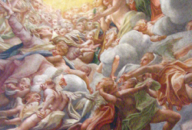COrreggio exhibition
parma, emelia romanga, Italy
Europe
November 16, 2008


COrreggio exhibition
parma, emelia romanga, Italy
Europe
November 16, 2008




The whole town of Parma was abuzz with the Corregio exhibition, staged in four important venues in the city and seven additional sites in the vicinity (within range at 10-48 km or 6-30 miles). The painter Corregio (Antonio Allegri) 1489-1534, known by the name of the town where he was born, spent his entire life in the area then known as Lombardy, bounded by Mantua, Reggio, Modena, Parma and Corregio. The painter worked principally in Parma, which possesses an extraordinary group of his masterpieces, some of which adorn the city’s churches. Henry was the hero of the day, making sure to obtain the series of timed tickets, offered only on the day of our visit, available at the Museo Diocesano near the Basilica Cattedrale di Parma. Our first entrance time was between Noon and 12:15 PM for the big museum show at the Galleria Nationale, in the 16th century Palazzo della Pilotta. The scale of the building and the exhibition were both daunting. Using audio guides offered only in Italian or English, we were able to navigate the entire exhibition on our own, wending our way through masses of Italian tourists following their guides, who were lecturing about various paintings. An impressive number of paintings, by Corregio, assembled here from major museums the world over, filled this cavernous space. This exhibition also included some paintings by Corregio’s contemporaries, architectural displays, softly-lit displays of drawings by Corregio and other major artists of the same era, as well as some religious objects and objets d’arte owned by the nobility during this time. The range of work in the show gave the visitor an impression of the art and fashion of the time, as well as the advancement in painting, as exhibited by the master, Mantegna, and Corregio, his student. Though most of the works of art in the exhibition were sacred in subject matter, one of the last rooms displayed three paintings of a profane nature, commissioned by Frederico II Gonzaga of Mantua, and intended as a gift for Charles V of Spain. A pair of paintings by Corregio: Juno and Io, and The Abduction of Ganymede were installed side by side, while a third painting, Danae, took its place on an adjacent wall. These three paintings, marvelously assembled in one room, were loaned from Vienna Kunsthistorisches Museum Gemäldegalerie and The Galleria Borghese in Rome. The exhibition underscores the standard set by the greatest painters working in Italy during the Renaissance: “the terribilitas of Michaelangelo, the surpreme poise of Raphael, the sfumato effects of Leonardo da Vinci, the color of Titian and the gracefulness of Correggio,” quoting the text of the exhibition brochure. This exhibition also sets out as its agenda, to put the painter, Corregio, in context, and thereby confirm his rightful place among the great artists of the Renaissance. Today, Corregio is seen for what he really is, beyond being a painter of charm. Again, quoting the curator of the show: “His work is infused with a kind of visual poetry, marked by intense expression of emotions, with a concern for rendering space and light, all elements combined as a precursor of the baroque sensibility which followed”. From this fully developed museum exhibition, Henry and I walked to the second stop on our daylong quest to see work by Corregio. At Il Duomo, known as the Basilica Cattedrale di Parma, we were allowed to enter at 2:15 for a fifteen minute visit, high above the nave of the church. Sturdy aluminum scaffolding had been constructed beneath the dome to put the visitors in range of seeing the details of the painting, The Assumption of the Virgin, the subject of which was chosen by the canons and vestrymen of the church, after the contract with Corregio had already been signed on November 3, 1522. This painting, flooded with yellow light, depicts an angel in full profile, coming to meet Mary to guide her to paradise. Surrounding her are a vortex of angels, Cherubim, Seraphim, all among the swollen clouds, supporting her, costumed in a pink dress and pale blue cloak. A cast of wise men, ancient prophets, and biblical figures are present to witness the event, including the twelve apostles, gathered by angels from their teachings in all the corners of the world. The wondrous crowd included her husband Joseph, Adam and Eve, with Eve holding a green apple. The implication here is that the two of them were forgiven for their sins. Also in the crowd are Solomé and Judith, with her maid holding the disembodied head of Holoferne. Abraham and his son Isaac are present with the sacrificial lamb. King David, King Solomon, Mary Magdalene, and even Corregio himself, is painted in as a self portrait among the admiring spectators. The third venue was Chiesa di San Giovanni Evangelista at 4:30 PM, after a lunch of parma ham and parmesan cheese. Again, the painting to be seen was in the dome. We got our exercise by climbing many flights of steps to the painting, the subject similar to the last dome we visited, entitled Vision of San Giovanni Evangelista depicting the ascension of Christ into heaven. This act is witnessed by all the apostles, sitting in pairs on clouds, with angels participating in the exalted act. The fourth and final stop on our Corregio tour was the Camera di San Paolo, a where Corregio had painted ceilings of several rooms. The most beautiful of these had a portrait of the goddess Diana in her chariot frescoed on the plastered fireplace chimney. Above this, looking like a woven hedge with oval shaped windows, was a fancifully vaulted ceiling, each oval opening possessing a charming putti at play. We finished the day with dinner on Borgo del Corregio, at Osteria I Tre Porcellini (The 3 Little Pigs) in the historic part of Parma. It was a great day!
PHOTOS: All photos are details from Corregio’s The Assumption of the Virgin in the dome of Il Duomo, Basilica Cattedrale di Parma.


Domenico, A Day of Sacred Art

